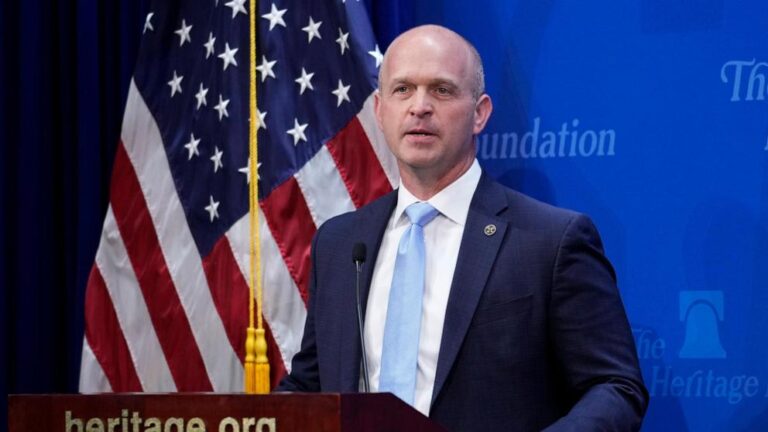WASHINGTON — The leader of a conservative think tank mischaracterized partisan differences on political violence in the United States on Thursday, falsely suggesting that people involved in left-wing activism commit more violent acts than those involved in right-wing activism.
___
Kevin Roberts, president of the Heritage Foundation: “Most of the political violence of the last 25 years has been perpetrated by the left.”
THE FACTS: Roberts’ comments were in response to a question about comments he made earlier this month in which he said, “America is in the middle of a second American Revolutionary War, and it will remain bloodless if the left lets it.”
Roberts told reporters on Thursday that he considers himself a historian of the American Revolutionary War and that his comments about a second revolution were a reference to the “ambitious policy agenda” the Republican Party has if former President Donald Trump wins the election in 2024. Roberts’ organization has proposed a sweeping overhaul of the federal government known as Project 2025.
Roberts said his comments about political violence should be seen in historical context.
But a closer look at the available evidence shows that right-wing groups have committed more acts of political violence in recent U.S. history.
Two years ago, a team of researchers from four universities examined court records and other data on 3,500 extremists active in the United States between 1948 and 2022. The individuals were divided into three groups: left-wing, right-wing and those associated with Islamic extremism. Some in the database had committed violent acts, but others had raised money for or volunteered for extremist groups or spoken out in support of them.
The researchers found that right-wing extremists were just as likely to commit violent acts as those motivated by Islamic extremism, with left-wing extremists coming in a distant third.
Gary Lafley, a professor at the University of Maryland and one of the study’s co-authors, said violence by left-wing groups has been declining for decades since violent incidents by extremist groups such as the Weather Underground, a far-left extremist organization founded in 1969.
Lafley, founding director of the National Consortium to Study Terrorism and Responses to Terrorism, which studies extremism and political violence, said violence by right-wing groups has far outnumbered violence by left-wing groups in recent years.
“There haven’t been many left-wing incidents recently,” Lafley said.
Lafley said that increasingly, many of those responsible for political violence describe themselves as anarchists who espouse a “confused ideology” that combines rejection of authority with conservative views, or who also claim to support authoritarianism. “Or they have no strong ideological commitment at all,” he added.
The attempted assassination of former Republican President Donald Trump on Saturday has brought renewed attention to questions about political violence and its place in American democracy. Some Trump supporters, including Trump’s running mate, J.D. Vance, have blamed the shooting on Democratic rhetoric.
But the assassination attempt on President Trump is just the latest in a string of violent incidents against public officials over more than a decade.
Democratic Rep. Gabby Giffords, who was shot and seriously injured outside an Arizona grocery store in 2011, had been threatened and had the windows of her Tucson office smashed after voting in favor of President Barack Obama’s health care reform, but a motive for the shooting was never determined.
Republican Rep. Steve Scalise, now House Majority Leader, was shot in 2017 while practicing for a charity baseball game by a gunman who reportedly had a grudge against President Donald Trump and the Republican Party, and Michigan’s Democratic governor, Gretchen Whitmer, was the target of a failed kidnapping plot uncovered in 2020.
In 2022, a man broke into then-House Speaker Nancy Pelosi’s home in San Francisco and beat her husband, fracturing his skull. Last year, a man with a history of mental illness went to Democratic Rep. Gerry Connolly’s campaign office in Fairfax, Virginia, and tried to kill him with a baseball bat. Connolly was out of town, so the man attacked two of his staff members.
The largest act of political violence in recent history was the attack on the U.S. Capitol on January 6, 2021, in which a mob of Trump supporters fought with police, vandalized the Capitol building, and attempted to prevent the certification of Joe Biden’s presidential victory.
Trump’s own inflammatory rhetoric and baseless lies about the 2020 election were blamed for inciting the Jan. 6 attack and other violent acts by his supporters. Trump also mocked the hammer attack on House Speaker Paul Pelosi, 80.
Sean Westwood, a political scientist at Dartmouth College and director of the Polarization Lab, said surveys over the years have consistently shown that Americans from both parties strongly oppose political violence.
Westwood said people typically tend to exaggerate the violent intentions of those with different ideologies, with one party believing the other is much more willing to use violence to further their political ends. That’s one reason it’s so important for leaders of both parties to come together to call for unity and peaceful dialogue, he said.
“Americans abhor violence,” Westwood said. “Even the most polarized people don’t support partisan violence.”
___
Read AP Fact Check here: https://apnews.com/APFactCheck.
___

